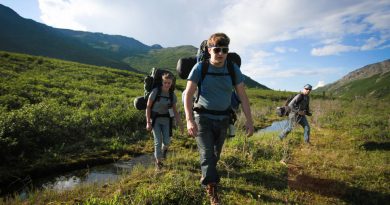7 Ways To Get Fit For Hiking In Just 10 Minutes A Day
 Pick one of these 10-minute techniques to work on every day, and in no time, you’ll be in your best trail shape ever.
Pick one of these 10-minute techniques to work on every day, and in no time, you’ll be in your best trail shape ever.
Can I really get fit for hiking in just 10 minutes a day?
If you’re just starting out, absolutely! You can develop strength, flexibility, and some anaerobic endurance to get fit for hiking in just 10 minutes per day. Heck, this study showed serious fitness improvements in even less time.
But there’s no such thing as a miracle cure for exercise. In order to build endurance, you really need to put the time in. What does that mean? Check out the 11 Things Every Hiker Should Know About Fitness, and read on for some truly good-for-you ideas of how to fill a spare 10 minutes.
1. Stretch.

A 10-minute stretch circuit decreases the chances of injury, can help to prevent muscle imbalances, and speeds recovery from hard hikes. Try this potent combo: 30 seconds of foam roller followed by 30 seconds of static stretching on the same muscle. Hikers should pay special attention to the calf, hamstring, quads, inner thigh, and IT band.
2. Use intervals to redline your cardio.

High-intensity interval training (HIIT) alternates short bursts of intense exercise with a recovery period. Start with a 2:1 ratio of high to low intensity (for example, 40 seconds of intense exercise followed by 20 seconds of recovery).
A good starter exercise: Jump rope to build ankle stability while improving your cardio. First, warm up by walking up and down stairs fast for 2-3 minutes. Next, jump rope for 40 seconds, as fast as you can while still maintaining control, then walk for 20 seconds to lower heart rate. Repeat for a total of 3-5 cycles. Finish with a 2-3 minute cool down by walking until your heart rate and breathing return to normal. Use a timer or a smartphone app like Gymboss to keep track of time and the number of rounds you’ve done.
3. Try TRX Suspension Training

If you are only going to buy one piece of fitness equipment, consider the TRX Suspension Trainer ($200; trxtraining.com), or see if your local gym has one hanging around (get it? “hanging”?). Most bodyweight training programs focus on the front of the legs, leading to muscle imbalances. Incorporating the TRX allows you to work the back of the legs too.
Try the TRX Hamstring Bicycle: Adjust the TRX so that the bottoms of the foot cradles are 12 inches off the ground. Lie on your back and place your heels in the foot cradles. Lift your hips off the ground and slowly bring one heel towards your hip, with your knee pointing toward the ceiling. Return to start position and repeat with other leg. Perform 12-20 repetitions, then rest for 60 seconds and repeat 1-2 more sets. Your hamstrings, hips, and core will thank you.
4. Build strength with circuit training

Circuit training means a series of exercises performed in a row, without rests. A well-designed circuit can target every major hiking muscle and improve cardio in less-than 10 minutes. Try this hiker-specific version: 12 squats (ideally holding a weight overhead); 12-20 pushups; 5-8 squat jumps; 20 mountain climbers; 20 Russian twists (alternate sides); 10 split squats (per leg).
5. Pretend you’re warming up for a hike

Static stretching (see #1) is best for after exercise; for a pre-hike warmup, you want dynamic flexibility exercises that use momentum to take each joint through its full range of motion. But you don’t have to wait for the trailhead to snag the benefits of stronger, more flexible ankles, knees, and hips. Try a dynamic flexibility circuit anytime you have 10 minutes to improve your hiking fitness. Good trail warmups include double heel lifts (try them on a step to get a good calf stretch too!), split squats, butt kickers, leg swings, and high knees. Pick 3-10 exercises and perform 10 repetitions per exercise. Keep the rest between exercises to a minimum.
6. Work on your balance.

Build leg strength, improve endurance, and strengthen your ankles, knees and hips with balance step-ups. Stand in front of a step or box, 6-12 inches high. Step up on the right leg and bring the your left knee up to waist height without letting your left foot touch the step. Reverse the move by bringing the left leg down to ground, followed by the right leg. Repeat on the other side. Perform 12-20 repetitions followed by 60 seconds of rest. Start with 2-3 sets; and add a pack with weight in it to increase the difficulty.
7. Visualize your next big challenge.

Visualizing your next big hike can improve your chances of success—just ask Olympic athletes. In a survey at the Olympic Training Center in Colorado Springs, 90% of athletes and 94% of coaches used imagery in their sport (1).
Make it work for you: Imagine the hike in as much detail as possible. Look at topographic maps, trip reports, and photos to see what challenges you might encounter. Now find a quiet place to sit down and close your eyes. Use all five senses as you visualize yourself on the trail. What are you wearing? What is the temperature? Are there any familiar smells? Go through the entire hike in your mind, paying special attention to obstacles such as river crossings or the never-ending switchbacks going over the pass. Imagining success will build confidence in your abilities before you ever reach the trailhead.
1. Micheal A. Clark, Scott C. Lucett NASM Essentials Of Sports Performance Training, Lippincott, Williams And Wilkins, 2010
James Fisher (coachjamesfisher.com) is a National Academy of Sports Medicine (NASM) Certified Personal Trainer, Performance Exercise Specialist, and Corrective Exercise Specialist. He lives in Sedona, Arizona, where he trains recreational athletes to be ready for any adventure they can imagine. His goal for 2015 is to survive climbing Zoroaster Temple in the Grand Canyon.
The article was originally seen at https://www.backpacker.com/skills/7-ways-to-get-fit-for-hiking-in-just-10-minutes-a-day
Originally posted 2018-05-07 06:47:30.




